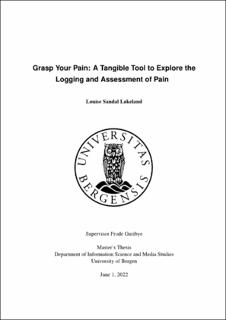| dc.description.abstract | Pain is a subjective and innate experience that can be difficult to describe. Chronic pain is associated with decreased quality of life, and it is prevalent in cancer populations. With a growing elderly population, the global cancer burden is expected to rapidly advance in the coming years. Expressing pain and symptom experiences is essential for patients to receive proper treatment and care. Self-reporting tools are useful and reliable measures of patients' symptoms. A commonly used assessment form in palliative care is ESAS-r, the revised Edmonton Symptom Assessment System. It lets the patient rate a list of symptoms, on a scale from 0 to 10, depending on their intensity. Research suggests that ESAS-r only captures a snapshot of the patients' symptom profile, and that is burdensome to patients and clinical staff. There is a need for self-assessment tools that are easy to use, non-intrusive, and can be used in situ. The research in this thesis explores the use of a tangible tool (Grasp), and squeezing as an input method to log pain/symptoms experiences. Grasp consists of a small stone-like object. When squeezed, it logs the time and duration of the interaction. Squeezes are then visualized on an accompanying interface. Through a Mixed Methods Research approach, a pilot study and clinical trial were conducted. The former gathered participant (N=8) opinions on Grasp, and the use of squeeze duration to log experiences. The latter explored the implementation of Grasp alongside ESAS-r in a cancer ward (nurses = 6, patients = 8). Two broad research questions were examined: RQ1: How can tangible interaction through Grasp support the logging of experiences? and RQ2: How do palliative cancer patients and nurses experience Grasp as a tool for the logging, assessment, and communication of pain and symptoms compared to ESAS-r? Findings from the pilot suggest that there is potential in using Grasp and squeeze duration to log events, and that interacting with the tool potentially can help distract or externalize from negative experiences. Participants from both studies found Grasp easy to use, and visualizations intuitive and meaningful. Nurses and patients were generally satisfied with Grasp as a tool, and it helped paint a wider image of the patients' symptoms compared to ESAS-r alone. However, patients were sometimes too ill to use Grasp, and the research was limited by barriers related to clinical environments. Further research is needed to explore the potential of tangible interaction and squeezing as an input method with other patient groups. There is also the aspect of the affective interaction that should be investigated further. | |
